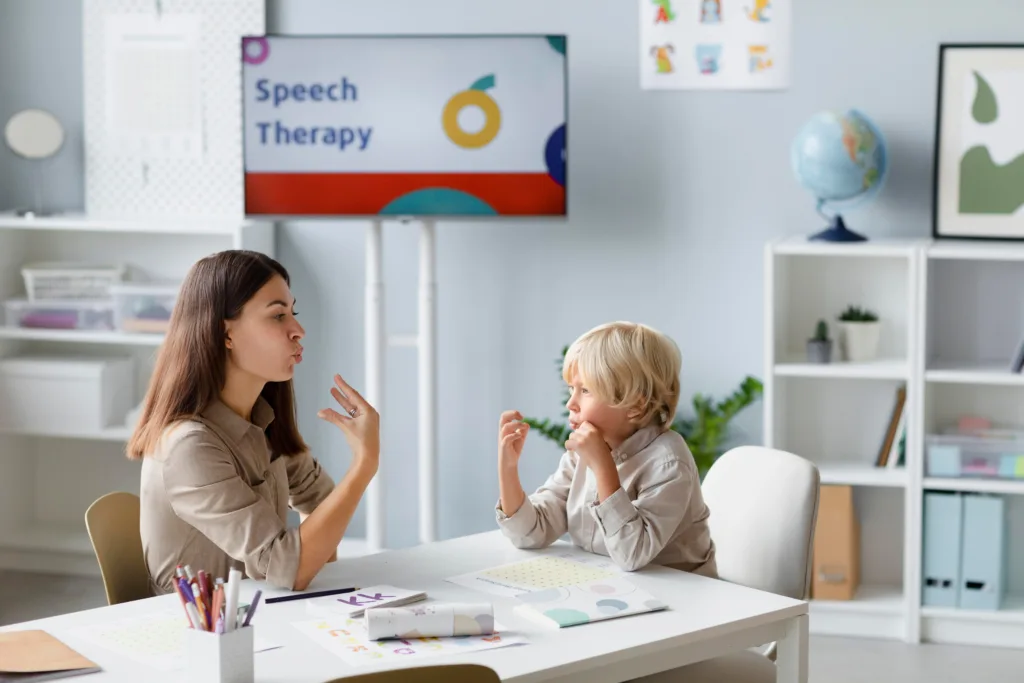Can a child’s early experiences forever change the way their brain develops? Research suggests that traumatic events in early childhood can significantly affect cognitive development and academic performance. According to the National Child Traumatic Stress Network, chronic exposure to trauma can alter a child’s ability to focus, organize, and process information.
This, in turn, can lead to difficulties in learning and memory, making it challenging for children to succeed academically. As we explore the complex relationship between trauma and cognitive functioning, we will examine how early adverse experiences reshape the developing brain and impact educational outcomes.
Key Takeaways
- Childhood trauma can significantly impact cognitive development and academic performance.
- Traumatic experiences can alter the way a child’s brain processes information and stores memories.
- Understanding the neurobiological impact of trauma is crucial for supporting affected children.
- Trauma-informed approaches can help mitigate long-term cognitive effects.
- Early intervention is key to supporting traumatized children in educational settings.
Understanding Childhood Trauma and Its Prevalence
Understanding the prevalence and effects of childhood trauma is essential for developing supportive interventions. Childhood trauma is a significant concern due to its potential long-term impact on an individual’s health and well-being.
The Adverse Childhood Experiences (ACEs) Study, which included over 17,000 participants aged 19 to 90, provides valuable insights into the prevalence of childhood trauma. Researchers collected medical histories and data on childhood exposure to abuse, violence, and impaired caregivers. The results showed that nearly 64% of participants experienced at least one adverse childhood experience, and of those, 69% reported two or more incidents of childhood trauma.
Defining Childhood Trauma and Adverse Childhood Experiences (ACEs)
Childhood trauma encompasses any experience that overwhelms a child’s ability to cope. This can include physical or emotional abuse, neglect, witnessing violence, natural disasters, serious accidents, or the loss of a caregiver. Adverse Childhood Experiences (ACEs) represent a specific framework for categorizing traumatic events that occur before age 18.
| Type of Trauma | Description | Potential Impact |
|---|---|---|
| Physical Abuse | Physical harm or injury inflicted on a child | Increased stress response, potential for physical injury |
| Emotional Abuse | Emotional harm or neglect, affecting a child’s self-esteem or emotional well-being | Difficulty with emotional regulation, low self-esteem |
| Neglect | Failure to provide for a child’s basic needs | Developmental delays, increased risk of mental health issues |
The cumulative impact of multiple ACEs creates a “dose-response” relationship, where the more adverse experiences a child faces, the greater the potential impact on their brain development and learning capacity. Understanding the prevalence of childhood trauma helps contextualize the widespread nature of trauma-related learning difficulties in educational settings.
The Neurobiology of Trauma: How Trauma Affects the Developing Brain
Trauma in early life can dramatically change the brain’s development trajectory, affecting both its structure and functionality. Childhood trauma literally alters the brain’s structure, particularly in areas crucial for learning and memory, such as the hippocampus, and in regions vital for attention and emotional regulation, like the prefrontal cortex.
The brain’s response to trauma is complex. When a child experiences trauma, it activates the brain’s stress response systems. This activation floods the developing brain with stress hormones like cortisol and adrenaline, potentially damaging neural connections. Chronic trauma keeps the brain in a state of hyperarousal, diverting resources from areas responsible for learning and memory to those focused on survival.
Stress Response Systems and Brain Development
The developing brain is particularly vulnerable to the effects of trauma because it is still forming. Repeated activation of stress responses can lead to lasting changes in the brain’s architecture. The sequence of brain development, from lower regions like the brainstem to higher regions such as the limbic system and cortex, makes the timing of trauma critical in understanding its impacts.
Trauma during sensitive developmental periods can disrupt the formation of neural circuits crucial for emotional regulation, attention, and executive functioning. Neuroimaging studies have shown measurable differences in brain structure and function between children with and without trauma histories, particularly in areas associated with learning and memory.
| Area of Brain | Function | Impact of Trauma |
|---|---|---|
| Hippocampus | Learning, Memory, Spatial Relationships | Altered structure, affecting learning and memory |
| Prefrontal Cortex | Attention, Emotional Regulation, Problem-Solving | Impaired development, affecting emotional regulation and problem-solving |
| Brainstem | Basic Functions, Survival Mechanisms | Enhanced survival responses, potentially at the cost of other functions |
Understanding these neurobiological changes is crucial for explaining why traditional educational approaches may be ineffective for children who have experienced trauma. By recognizing the impact of trauma on the developing brain, we can begin to develop more effective support strategies for these children.
The Connection Between Childhood Trauma and Learning
When children experience trauma, their brain’s response can hinder the learning process. The brain’s stress response becomes activated, consuming a significant amount of emotional bandwidth, which can lead to learning taking a backseat.
As explained by experts, “Trauma puts the child’s mind and the body into fight-or-flight mode and redirects energy away from more sophisticated developmental needs, like well-tuned emotion regulation, cognitive processes (such as attention), and high-level social cognition like identity and relationship formation.” This redirection of energy has a profound impact on a child’s ability to engage with the learning process.
Disruptions in the Learning Process
Trauma fundamentally alters a child’s ability to learn by keeping their brain in survival mode rather than learning mode. Several key factors contribute to this disruption:
- Attentional Control: Children experiencing trauma often struggle with attentional control, making it difficult to focus on academic content when their brains are scanning for potential threats.
- Cognitive Resources: The learning process requires cognitive resources for information processing, memory formation, and problem-solving—all functions that become compromised when a child’s brain is overwhelmed by traumatic stress.
- Academic Engagement: Trauma can create significant barriers to academic engagement, as children may appear distracted, disinterested, or defiant when they’re actually experiencing trauma-related cognitive disruptions.
- School Environment: School environments contain numerous potential trauma triggers that can activate stress responses and interrupt learning, including loud noises, transitions, performance pressure, or interpersonal conflicts.
- Maladaptive Coping Mechanisms: Children with trauma histories often develop maladaptive coping mechanisms that further interfere with learning, such as dissociation during challenging academic tasks or behavioral outbursts when feeling overwhelmed.
Understanding how trauma specifically disrupts learning processes allows educators to develop targeted interventions that address the root causes rather than just the symptoms. By recognizing the signs of trauma and its impact on learning, educators can create a more supportive and inclusive learning environment.
The Connection Between Childhood Trauma and Learning
Childhood trauma can trigger various survival responses in children, affecting their behavior and learning outcomes in school. When a child experiences trauma, their body’s stress response is activated, leading to different coping mechanisms.
Fight, Flight, Freeze, and Fawn Responses in Educational Settings
Trauma can lead to the freeze response, where a child shuts down to avoid threats, and the fawn response, where they focus on others’ needs while neglecting their own. For instance, a child in a ‘fight response’ may exhibit impulsive decision-making and have difficulty self-regulating, while a child in a ‘freeze response’ might withdraw from others or appear to zone out.
Children with trauma histories often display these survival responses in educational settings, which can be misinterpreted as behavioral problems or learning disabilities. Understanding these responses is crucial for providing appropriate support.
- The “fight” response may manifest as aggression or defiance when a student feels threatened by academic challenges.
- The “flight” response can appear as task avoidance or chronic absenteeism when school environments trigger trauma memories.
- The “freeze” response often presents as daydreaming or dissociation during instruction.
- The “fawn” response involves excessive people-pleasing, where traumatized students prioritize others’ needs over their own learning needs.
Recognizing these responses as trauma reactions rather than willful misbehavior is essential for implementing interventions that support rather than punish affected students. By doing so, educators can create a more supportive learning environment that acknowledges the impact of trauma on a child’s behavior and learning experience in school.
It’s crucial for educators to understand that these survival responses are automatic and represent the brain’s attempt to protect itself from perceived threats. By acknowledging this, we can work towards creating a safe and supportive environment for all children to thrive academically and personally.
Impact on Memory Formation and Retention
When children experience trauma, their brain’s ability to form and retain memories can be significantly impaired. This is because the brain’s response to trauma can alter the development and functioning of areas critical for memory, such as the hippocampus and prefrontal cortex.
Effects on Working Memory
Working memory, the cognitive system responsible for temporarily holding and manipulating information, is particularly vulnerable to the effects of trauma. Stress hormones directly impact the hippocampus and prefrontal cortex, areas of the brain crucial for working memory. As a result, children with trauma histories often struggle with working memory capacity.
This struggle manifests in several ways, including difficulty following multi-step instructions, forgetting assignments, and losing track during complex tasks. The impact on working memory is not a reflection of a child’s intelligence or motivation but rather a neurobiological consequence of trauma.
- Trauma can disrupt the encoding process, where information transitions from working memory to long-term storage, resulting in gaps in learning.
- Children may appear to understand material one day but not retain it the next, due to the challenges in consolidating information from working memory to long-term memory.
- Educators can implement targeted strategies to support these children, such as breaking down instructions, providing visual supports, and creating predictable routines.
Understanding the specific impact of trauma on working memory allows for the development of tailored interventions. By acknowledging that these memory challenges are neurobiological in nature, educators and caregivers can provide more effective support.
“The brain’s response to trauma can significantly alter its development, particularly in regions crucial for memory and learning.”
Expert in Child Trauma
Impact on Memory Formation and Retention
Trauma experienced during childhood can have lasting effects on memory, influencing both explicit and implicit memory processes. When children encounter traumatic events, their brains process these experiences differently, often leading to disruptions in normal memory development.
Long-term Memory Disruptions in Traumatized Children
Dissociation is a common phenomenon in children with complex trauma histories. When faced with an overwhelming experience, they may dissociate, or mentally separate themselves from the event. This can manifest as feeling detached from their bodies or perceiving the experience as happening to someone else. As a result, they may lose memories or the sense of these experiences, creating gaps in their personal history.
Trauma significantly impacts long-term memory systems, creating disruptions in both explicit memory (conscious recall of facts and events) and implicit memory (unconscious procedural learning). Children with trauma histories often experience fragmented autobiographical memories, making it difficult to construct coherent narratives about their lives and educational experiences.
- Traumatic memories are stored differently than ordinary memories, sometimes remaining unintegrated in the brain and causing intrusive flashbacks that interfere with new learning.
- The phenomenon of state-dependent memory means that information learned in one emotional state (e.g., a calm classroom) may be inaccessible when a child is in a different emotional state (e.g., triggered or stressed).
- Trauma can create dissociative barriers to memory, where children psychologically disconnect from overwhelming experiences, creating gaps in memory that affect academic continuity.
- These memory disruptions often result in an inconsistent learning profile, where a child may demonstrate mastery of material on some days but appear to have forgotten it entirely on others.
- Understanding long-term memory disruptions helps explain why traditional educational approaches emphasizing repetition and practice may be insufficient for trauma-affected learners.
By recognizing the impact of trauma on memory formation and retention, educators and caregivers can develop more effective strategies to support children with trauma histories, ultimately enhancing their learning experiences and outcomes.
Cognitive Challenges Faced by Trauma-Exposed Children
One of the most significant cognitive challenges faced by trauma-exposed children is their struggle with attention and concentration. Trauma can profoundly affect a child’s ability to focus, leading to difficulties in academic settings. Understanding these challenges is crucial for developing effective support strategies.
Attention and Concentration Difficulties
Children who have experienced trauma often display significant attention difficulties due to their brain’s heightened state of alertness to potential threats. This hypervigilance can manifest as an inability to sustain focus on academic tasks, frequent distraction by minor stimuli, or hyperfocus on perceived threats, all of which detract from classroom instruction.
The brain’s attentional systems are recalibrated following trauma, prioritizing the detection of danger signals over academic information. This recalibration makes traditional classroom expectations particularly challenging for trauma-affected children. As a result, these children may appear to have attention deficit disorders, but the underlying mechanisms differ, requiring trauma-specific interventions rather than standard ADHD approaches.
- Concentration difficulties often fluctuate based on environmental triggers, stress levels, and perceived safety, creating an inconsistent pattern that can confuse educators.
- These attention challenges directly impact academic performance across all subject areas, as attention is foundational to learning new information and developing skills.
- Understanding the neurobiological basis of these attention difficulties helps shift perspective from seeing children as “choosing not to pay attention” to recognizing their genuine struggles with attentional control.
By acknowledging the impact of trauma on a child’s brain and its attentional systems, educators and caregivers can begin to develop strategies that support these children. This includes creating a safe learning environment and adapting teaching methods to better meet the needs of trauma-exposed children.
Cognitive Challenges Faced by Trauma-Exposed Children
Trauma exposure in children can lead to substantial difficulties in problem-solving and critical thinking, essential skills for academic success. These cognitive challenges are multifaceted and can significantly impact a child’s ability to learn and succeed in educational settings.
Impairments in Problem-Solving and Critical Thinking
Children who have experienced trauma may exhibit difficulties in acquiring new skills or absorbing new information. Their capacity for sustaining attention or curiosity can be compromised, often due to distractions stemming from reactions to trauma reminders. Moreover, these children may display deficits in language development and abstract reasoning skills, further complicating their academic journey.
- Impact on Higher-Order Cognitive Functions: Trauma significantly affects higher-order cognitive functions, including problem-solving abilities, critical thinking, and abstract reasoning—skills that are crucial for achieving academic success.
- Rigid Thinking Patterns: Children with trauma histories often demonstrate rigid thinking patterns, struggling with cognitive flexibility and the ability to consider multiple solutions to problems.
- Executive Functioning Skills: Executive functioning skills, including planning, organizing, and self-monitoring, are particularly vulnerable to the effects of trauma, as these functions are centered in the prefrontal cortex, an area highly sensitive to stress hormones.
- Present-Focused Orientation: Trauma-affected children frequently develop a present-focused orientation, making it difficult to engage in the future-oriented thinking required for academic planning and goal-setting.
- Manifestation Across Curriculum: Problem-solving difficulties manifest in various ways across the curriculum, from struggling with mathematical word problems to difficulty analyzing literature or navigating social conflicts.
- Pattern of Learned Helplessness: These cognitive challenges often lead to a pattern of learned helplessness, where children quickly give up on challenging tasks rather than persisting through difficulties.
- Educational Support: Understanding these specific cognitive impairments allows educators to scaffold learning experiences appropriately, breaking complex tasks into manageable steps and explicitly teaching problem-solving strategies.
By recognizing the cognitive challenges faced by trauma-exposed children, educators and caregivers can provide targeted support to help these children overcome their difficulties and achieve academic success.
Cognitive Challenges Faced by Trauma-Exposed Children
The impact of childhood trauma extends into the realm of language development, affecting both the understanding and expression of language. Children who have experienced trauma may exhibit difficulties in language processing, which can significantly hinder their academic progress and social interactions.
Language Development and Processing Issues
Trauma can significantly impact language development and processing, affecting both receptive language (understanding) and expressive language (communication) skills. This can manifest in various ways, including delays in vocabulary development, complex syntax, and narrative abilities, which are foundational skills for academic success across subject areas.
Children with trauma histories often demonstrate difficulties in following verbal instructions, misinterpreting social cues, or struggling to express their thoughts and feelings appropriately. Moreover, trauma can create specific challenges with emotional vocabulary, making it difficult for children to identify and verbalize their internal experiences, further complicating their educational journey.
Key Challenges in Language Development:
- Difficulty with vocabulary development and complex syntax
- Struggles with narrative abilities and storytelling
- Trouble understanding and following verbal instructions
- Misinterpreting social cues and expressing thoughts and feelings
- Challenges with emotional vocabulary and identifying internal experiences
The relationship between trauma and language is bidirectional—language delays can increase vulnerability to trauma effects, while trauma can exacerbate language processing difficulties. Understanding this complex interplay is crucial for educators to implement targeted supports.
| Language Skill | Impact of Trauma | Support Strategies |
|---|---|---|
| Receptive Language | Difficulty understanding verbal instructions | Simplified instructions, visual aids |
| Expressive Language | Struggling to express thoughts and feelings | Opportunities for multimodal expression, emotional vocabulary building |
| Narrative Abilities | Delays in narrative development | Storytelling activities, narrative therapy |
By recognizing the specific impact of trauma on language development, educators can provide more effective support to children who have experienced trauma, enhancing their academic and social outcomes.
Behavioral Manifestations of Trauma in Educational Settings
Understanding the behavioral manifestations of trauma is essential for educators to support affected students effectively. Children who have experienced trauma may display a range of behaviors that can be challenging for teachers and peers to understand.
Disruptive Behaviors and Their Connection to Trauma
Disruptive behaviors in the classroom often represent trauma responses rather than willful misconduct. These behaviors stem from the brain’s survival mechanisms when triggered by perceived threats. Children with trauma histories may exhibit explosive anger, aggression, defiance, or opposition when faced with situations that activate their stress response systems.
Some common behavioral signs that might be observed in traumatized children include:
- Angry outbursts
- Avoiding peers and teachers
- Conflict with peers
- Hypervigilance
- Lowered grades
- Trouble with eye contact
These behavioral manifestations frequently occur during transitions, unstructured time, or challenging academic tasks—situations that increase stress and decrease predictability for trauma-affected students. Disruptive behaviors serve protective functions for traumatized children, creating distance from perceived threats or giving them a sense of control in environments where they feel vulnerable.
The traditional disciplinary approaches of consequences and punishment often exacerbate rather than improve these behaviors, as they fail to address the underlying neurobiological drivers. Schools frequently misinterpret trauma-related behaviors as conduct disorders, oppositional defiant disorder, or attention deficit hyperactivity disorder, leading to inappropriate interventions.
By understanding the connection between disruptive behaviors and trauma, educators can implement trauma-sensitive responses that address the root causes rather than just the behavioral symptoms. This approach not only supports the well-being of traumatized children but also creates a more compassionate and effective learning environment.
Behavioral Manifestations of Trauma in Educational Settings
Educators often observe a range of behaviors in students who have experienced trauma, including withdrawal and avoidance, which can significantly affect their learning outcomes. Understanding these behaviors is crucial for creating a supportive educational environment.
Recognizing Withdrawal and Avoidance Behaviors
Withdrawal and avoidance represent common but often overlooked trauma responses in educational settings. These behaviors can manifest in various ways, making it essential for educators to be aware of the signs.
- Children with trauma histories frequently employ avoidance strategies to escape triggering situations, such as task refusal or frequent disengagement from classroom activities.
- Social withdrawal may appear as isolation from peers, reluctance to participate in group activities, or difficulty forming and maintaining relationships with classmates and teachers.
- Academic avoidance often results in chronic absenteeism, incomplete assignments, or selective participation only in areas where the student feels confident and safe.
These avoidance behaviors serve protective functions, helping children manage overwhelming emotions and prevent retraumatization in educational environments. However, they are often misinterpreted as laziness, lack of motivation, or disinterest, rather than recognized as a trauma response requiring specific intervention.
Understanding the Impact
It’s crucial to understand that withdrawal and avoidance behaviors are coping mechanisms for children who have experienced trauma. By recognizing these behaviors as trauma responses, educators can implement supportive approaches that gradually build safety and engagement.
| Behavioral Manifestation | Description | Supportive Strategy |
|---|---|---|
| Task Refusal | Avoidance of specific tasks that trigger memories or feelings associated with the trauma. | Offer alternative tasks or modify existing ones to make them more manageable and less triggering. |
| Social Withdrawal | Isolation from peers and reluctance to participate in group activities. | Encourage gradual participation in small group settings, fostering a sense of safety and trust. |
| Chronic Absenteeism | Frequent absence from school, potentially due to feelings of anxiety or fear related to the school environment. | Develop a personalized attendance plan, providing support and incentives for regular attendance. |
By acknowledging the complexities of trauma and its impact on behavior, educators can create a more compassionate and supportive learning environment. This approach not only aids in the academic success of students with trauma histories but also contributes to their overall well-being.
Emotional and Social Impacts Affecting Academic Performance
The impact of trauma on a child’s self-concept and future orientation is a critical factor in their academic performance. Children learn their self-worth from the reactions of others, particularly those closest to them. Caregivers have the greatest influence on a child’s sense of self-worth and value.
Self-Concept and Future Orientation
Abuse and neglect can make a child feel worthless and despondent. A child who is abused will often blame him- or herself, as it may feel safer than recognizing the parent as unreliable and dangerous. This self-blame can lead to shame, guilt, low self-esteem, and a poor self-image, common among children with complex trauma histories.
Trauma profoundly impacts a child’s self-concept, often leading to internalized beliefs about being damaged, unworthy, or incapable of academic success. Children with trauma histories frequently develop negative academic self-efficacy—the belief that they cannot succeed at school regardless of effort—leading to reduced motivation and engagement.
- Trauma disrupts future orientation, making it difficult for children to envision positive futures for themselves or connect current academic efforts to long-term goals.
- The development of a coherent sense of self is compromised by trauma, as children struggle to integrate traumatic experiences into their understanding of who they are and what they can become.
- These negative self-perceptions create a self-fulfilling prophecy, where children avoid academic challenges, receive poor results, and have their negative beliefs reinforced.
Understanding how trauma shapes self-concept allows educators to implement specific interventions focused on building positive identity development and future orientation alongside academic skills. By recognizing the impact of trauma on a child’s self-concept, educators can help children develop a more positive self-image and improve their academic performance.
As adult supporters, we play a crucial role in helping children regain a sense of control over their lives and academic success. By fostering positive relationships and providing a supportive environment, we can help children overcome the negative impacts of trauma and achieve their full potential.
Emotional and Social Impacts Affecting Academic Performance
Trauma can profoundly affect a child’s emotional well-being, leading to difficulties in controlling their emotions and engaging in the learning process. Children who have experienced complex trauma often have difficulty identifying, expressing, and managing emotions. They may have limited language for feeling states and can internalize and/or externalize stress reactions, leading to significant depression, anxiety, or anger.
Difficulties with Emotional Regulation
Trauma significantly impairs emotional regulation—the ability to identify, express, and modulate emotions appropriately—creating substantial barriers to academic engagement and success. Children with trauma histories often experience emotional flooding, where feelings become overwhelming and hijack cognitive resources needed for learning and social interaction.
Emotional dysregulation can manifest in various ways in educational settings. This includes emotional outbursts, shutting down, mood swings, or inappropriate emotional responses to minor triggers. The brain’s emotion regulation systems, centered in the prefrontal cortex and limbic regions, are particularly vulnerable to trauma’s effects, explaining why traditional behavioral approaches often fail.
Traumatized children frequently lack emotional vocabulary and awareness, making it difficult for them to recognize and communicate their feelings before reaching a crisis point. These regulation difficulties create a cycle where emotional disruptions interfere with learning, academic struggles trigger more emotional distress, and the pattern continues.
Understanding the neurobiological basis of these regulation challenges allows educators to implement co-regulation strategies and explicit emotional skills instruction alongside academic content. By doing so, educators can help children develop better emotional regulation, improving their ability to engage with the curriculum and achieve academic success.
Emotional and Social Impacts Affecting Academic Performance
The impact of childhood trauma extends beyond the individual, affecting their ability to form healthy peer relationships and engage in collaborative learning. Children who have experienced trauma often struggle with developing a strong, healthy attachment to caregivers, which in turn affects their relationships with peers and authority figures.
Our ability to develop healthy, supportive relationships with friends and significant others depends on having first developed those kinds of relationships in our families. A child with a complex trauma history may have problems in romantic relationships, in friendships, and with authority figures, such as teachers or police officers.
Challenges in Peer Relationships
Trauma fundamentally disrupts a child’s ability to form and maintain healthy peer relationships, creating social challenges that directly impact collaborative learning opportunities. Children with trauma histories often misinterpret social cues, perceiving neutral interactions as threatening based on their past experiences of betrayal or harm.
- Social difficulties manifest in various ways, including social isolation, conflict with peers, difficulty sharing or cooperating, or inappropriate boundaries in relationships.
- Trauma-affected children frequently struggle with perspective-taking and empathy, essential skills for successful group work and the social aspects of classroom learning.
- These social challenges create a cycle of peer rejection that further reinforces negative self-perceptions and reduces opportunities for positive social learning experiences.
As
“The classroom’s social demands—group projects, partner work, playground interactions—can be particularly overwhelming for children whose early relationship templates were shaped by trauma.”
Understanding these social impacts allows educators to implement specific supports for social skill development and carefully structure collaborative learning experiences to ensure success.
By acknowledging the challenges faced by children with trauma histories, we can work towards creating a more supportive and inclusive learning environment that fosters healthy social development and promotes academic success.
Physical and Somatic Manifestations That Interfere with Learning
Trauma exposure in early life is associated with a range of physical health problems that can hinder a child’s educational progress. The Adverse Childhood Experiences (ACE) Study has shown a significant link between childhood trauma and increased medical conditions throughout an individual’s life.
Children who have experienced trauma are more likely to have compromised immune systems, making them more vulnerable to illnesses. This vulnerability can lead to frequent absences from school, disrupting their learning continuity. Moreover, traumatized children often experience psychosomatic symptoms such as headaches, stomachaches, and fatigue, which are physical manifestations of their psychological distress.
Chronic Health Issues and School Attendance
Chronic health conditions are more prevalent among children who have been exposed to trauma. These conditions can create significant barriers to consistent school attendance and engagement. For instance, sleep disturbances, including nightmares and insomnia, are common among traumatized children. Such sleep issues can affect their cognitive functioning and learning capacity the following day.
The relationship between trauma and physical health creates a vicious cycle: health problems lead to missed instruction, academic struggles increase stress, and heightened stress further compromises physical health. Understanding this cycle is crucial for educators to recognize that absenteeism may often be a reflection of genuine physical symptoms rather than mere avoidance.
Impact of Trauma on Physical Health and School Attendance
| Physical Health Impact | Effect on School Attendance | Consequence on Learning |
|---|---|---|
| Compromised immune function | Frequent absences due to illness | Missed instruction and falling behind academically |
| Psychosomatic symptoms (headaches, stomachaches, fatigue) | Partial-day absences or avoiding certain classes | Difficulty in keeping up with coursework and assignments |
| Sleep disturbances (nightmares, insomnia) | Inconsistent attendance and tardiness | Impaired cognitive functioning and reduced learning capacity |
School attendance patterns can often reflect a child’s trauma history, with some children missing specific classes or activities that trigger trauma responses. By understanding these physical manifestations, educators can adopt a more collaborative approach with health providers to support these children.
Physical and Somatic Manifestations That Interfere with Learning
Children who have experienced trauma often exhibit a range of physical and somatic manifestations that can significantly impact their ability to learn and succeed in school. These manifestations can be particularly challenging for educators and parents to address, as they may not be immediately recognizable as trauma-related.
Somatic Complaints and Their Impact on School Performance
Somatic complaints, or physical symptoms without a clear medical reason, are a frequent consequence of trauma in children and can interfere with their learning process. These complaints can include frequent illnesses, physical ailments such as stomach aches, and other body-based signs that are not easily linked to a specific medical condition.
Complexly traumatized youth frequently suffer from body dysregulation, meaning they may over-respond or under-respond to sensory stimuli. For instance, they might be hypersensitive to sounds, smells, touch, or light, or they might experience anesthesia and analgesia, where they are less aware of pain, touch, or internal physical sensations. This dysregulation can lead to difficulties in managing their physical responses in a classroom setting.
- Somatic complaints impact school performance: Physical symptoms without a clear medical cause can significantly affect a child’s ability to engage with academic material and participate fully in school activities.
- Interoceptive awareness: Children with trauma histories may experience heightened sensitivity to internal bodily sensations or, conversely, a disconnection from their bodily signals, both of which can interfere with their learning.
- Disruptions in academic continuity: Somatic manifestations often result in visits to the school nurse, requests to call parents, or early dismissals, all of which disrupt the continuity of their academic experience.
- Sensory processing difficulties: Trauma-affected children commonly experience sensory processing challenges, leading to hypersensitivity or hyposensitivity to various classroom stimuli.
- Genuine experiences: It’s essential to recognize that these physical complaints are genuine experiences for the child, not attempts to manipulate or escape academic demands.
- Stress response system dysregulation: Trauma can lead to dysregulation of the body’s stress response system, creating physical symptoms that vary in intensity based on the child’s perceived safety and stress levels.
- Implementing accommodations: Understanding these somatic manifestations allows schools to implement appropriate accommodations, such as sensory breaks, quiet spaces, or modified physical environments, to support the learning of traumatized children.
To better understand the impact of somatic complaints on school performance, let’s examine some key factors in a structured format:
| Somatic Complaint | Impact on Learning | Potential Accommodation |
|---|---|---|
| Frequent illnesses and physical ailments | Missed school days and difficulty keeping up with coursework | Flexible attendance policies and modified assignments |
| Hypersensitivity to sensory stimuli | Difficulty focusing in class due to overwhelming sensory inputs | Providing a quiet workspace or sensory breaks |
| Disconnection from bodily signals | Challenges in self-regulating emotions and behaviors | Teaching self-regulation techniques and emotional awareness |
Trauma-Informed Approaches in Educational Settings
Creating a safe and supportive environment is the cornerstone of trauma-informed educational approaches. The single most important thing a school can do is create a caring, safe environment that supports students and is sensitive to the complex dynamics of life that might be fueling childhood trauma.
Core Principles of Trauma-Informed Care
Trauma-informed educational approaches are built on core principles that fundamentally shift how schools understand and respond to student behavior and learning challenges. These principles are designed to support children who have experienced trauma, ensuring they receive the care and support they need to succeed academically and personally.
- Safety: Creating environments where children experience both physical and psychological security consistently.
- Trustworthiness and Transparency: Ensuring school procedures are predictable, and adults are reliable in their responses to children’s needs.
- Peer Support and Mutual Self-Help: Incorporating positive relationships that are healing for trauma-affected children.
- Collaboration and Mutuality: Emphasizing sharing power with rather than exerting power over students, giving them appropriate choices and control within the educational environment.
- Empowerment, Voice, and Choice: Prioritizing the development of agency and self-advocacy skills that counteract the helplessness often experienced during trauma.
- Cultural, Historical, and Gender Considerations: Integrating these factors into all aspects of the educational approach, recognizing how identity factors influence trauma experiences and responses.
By implementing these principles, schools can create a supportive environment that addresses the diverse needs of their students. The following table summarizes the key elements of trauma-informed care in schools:
| Principle | Description | Impact on Students |
|---|---|---|
| Safety | Physical and psychological security | Reduces anxiety and stress |
| Trustworthiness and Transparency | Predictable procedures and reliable adults | Increases trust and stability |
| Peer Support and Mutual Self-Help | Positive relationships and mutual support | Fosters a sense of community and healing |
| Collaboration and Mutuality | Sharing power and giving choices | Enhances student autonomy and engagement |
| Empowerment, Voice, and Choice | Developing agency and self-advocacy | Counteracts feelings of helplessness |
| Cultural, Historical, and Gender Considerations | Integrating identity factors into education | Recognizes and respects individual experiences |
By adopting trauma-informed approaches, schools can make a significant positive impact on the lives of children who have experienced trauma, supporting their academic success and personal well-being.
Trauma-Informed Approaches in Educational Settings
For children affected by trauma, a safe and supportive school environment is not just beneficial, it’s essential for their academic and personal growth. The National Child Traumatic Stress Network has created resources to help schools build trauma-informed environments, addressing the needs of all students, staff, administrators, and families at risk of experiencing traumatic stress symptoms.
Creating Safe Learning Environments
Creating physically and emotionally safe learning environments is fundamental to supporting trauma-affected children, as safety is a prerequisite for learning and development. This involves not just the physical classroom setup but also the establishment of predictable routines and clear expectations, which help reduce anxiety for these children.
By doing so, trauma-affected children can focus their cognitive resources on learning rather than threat detection. The classroom physical environment can be designed to support regulation, including designated calm spaces, sensory tools, and visual supports that help children navigate the school day.
Relationship safety—consistent, non-threatening interactions with adults and peers—provides the foundation for academic engagement and risk-taking necessary for learning. This emphasizes the importance of trauma-sensitive discipline approaches that focus on teaching skills rather than punishment, recognizing that challenging behaviors often stem from skill deficits rather than willful misconduct.
Moreover, creating cultural and identity safety ensures that children’s diverse backgrounds and experiences are respected and valued, reducing the additional stress of discrimination or marginalization. As noted by experts, “Safe learning environments extend beyond the classroom to include all school spaces and interactions, from hallways and cafeterias to playgrounds and special events.”
- Predictable routines help reduce anxiety.
- Classroom environments can be designed to support regulation.
- Relationship safety is crucial for academic engagement.
- Trauma-sensitive discipline approaches are essential.
- Cultural and identity safety is vital for reducing additional stress.
Trauma-Informed Approaches in Educational Settings
Evidence-based interventions are crucial in helping students overcome the impacts of trauma on their learning and memory. By adopting trauma-informed practices, schools can create a supportive environment that fosters academic success and emotional well-being for all students.
Effective Interventions for Trauma-Affected Students
Research has shown that when staff members incorporate trauma-aware practices in the classroom, students improve their academic performance. A 2019 study found significant improvements in students’ academic outcomes when trauma-informed practices were implemented. Similarly, a 2020 study of trauma-informed elementary schools saw marked improvements in classroom dynamics compared to those without such systems in place.
Several evidence-based interventions have been identified as particularly effective for trauma-affected students. These include:
- Universal Approaches: Implemented schoolwide, these approaches create a foundation for trauma-informed care that benefits all students.
- Targeted Interventions: For students with identified needs, targeted interventions provide additional support tailored to their specific circumstances.
- Multi-Tiered Systems of Support: This framework allows schools to deliver trauma-informed practices at various levels, from universal to intensive support.
- Cognitive-Behavioral Interventions: Adapted for educational settings, these interventions help students identify and modify trauma-related thought patterns that interfere with learning.
- Mindfulness and Self-Regulation Programs: By teaching concrete skills for managing physiological and emotional responses to stress, these programs create a foundation for improved learning capacity.
- Relationship-Based Interventions: Focusing on repairing attachment disruptions through consistent, positive interactions with caring adults, these interventions are critical in supporting students’ emotional and social development.
The effectiveness of these interventions is supported by research demonstrating that trauma-informed approaches improve not only psychological outcomes but also academic performance, attendance, and behavioral indicators. Moreover, implementation science highlights the importance of whole-school approaches rather than isolated interventions, with administrative support and ongoing professional development being critical success factors.
By understanding and implementing these evidence-based interventions, educators and policymakers can work together to create educational environments that support the diverse needs of trauma-affected students, ultimately enhancing their academic success and overall well-being.
Supporting Children with Trauma Histories: Resources and Strategies
Trauma-informed care for children involves not just the school environment but also the family and community. To effectively support these children, we need to adopt a comprehensive approach that includes educators, mental health professionals, families, and community resources working together.
You can start by implementing practical classroom strategies that provide predictable routines, clear transitions, and opportunities for choice. Accommodations for trauma-related learning challenges are also essential. For instance, some children may benefit from extra time to complete assignments or the use of a quiet space for tests.
Parent and caregiver partnerships are vital in this process. By working together with parents, you can ensure consistent approaches across home and school environments, maximizing effectiveness and providing comprehensive support to children with childhood trauma. This collaboration can help in identifying the specific needs of each child and tailoring interventions accordingly.
Professional development for all school staff is another critical component. This includes training for teachers, administrators, support staff, and transportation personnel to ensure a consistent trauma-informed approach throughout the child’s educational experience. Resources such as the Trauma-Informed Care Implementation Resource Center and SAMHSA’s Trauma and Justice Strategic Initiative can provide valuable guidance.
Community partnerships with mental health providers, social services, and cultural organizations can expand the resources available to support trauma-affected children and their families. For example, organizations like the National Child Traumatic Stress Network (NCTSN) offer a wealth of information and tools for supporting children with trauma histories.
Key Resources for Supporting Children with Trauma Histories
| Resource | Description | Benefit |
|---|---|---|
| Trauma-Informed Care Implementation Resource Center | Provides guidance on implementing trauma-informed care practices | Enhances staff understanding and response to trauma |
| SAMHSA’s Trauma and Justice Strategic Initiative | Offers resources and strategies for addressing trauma related to the justice system | Supports children and families affected by trauma and justice issues |
| National Child Traumatic Stress Network (NCTSN) | Provides education, resources, and tools for supporting children with trauma | Empowers educators and families to support trauma-affected children |
| Sesame Street in Communities | Offers resources for supporting children through difficult experiences, including trauma | Provides accessible materials for children and caregivers |
Lastly, it’s crucial for educators working with traumatized children to practice self-care. Secondary traumatic stress can impact teaching effectiveness and personal wellbeing. By prioritizing self-care, educators can maintain their ability to provide high-quality support to children with trauma histories.
By leveraging these resources and strategies, we can create a more supportive and inclusive environment for children who have experienced trauma, ultimately enhancing their ability to learn and thrive.
Conclusion
As we have explored, childhood trauma significantly affects children’s brain development and learning capabilities. The impact of trauma on the developing brain creates significant challenges for learning, memory formation, and academic achievement.
The neurobiological impact of childhood trauma explains why traditional educational approaches often fail with trauma-affected children, highlighting the need for trauma-informed alternatives. By understanding the specific cognitive, emotional, social, and physical manifestations of trauma in educational settings, we can provide more accurate identification and appropriate intervention.
Trauma-informed educational practices represent a paradigm shift that benefits not only trauma-affected children but creates more supportive learning environments for all students. The implementation of trauma-sensitive approaches requires systemic change, including policy development, professional training, and resource allocation to support comprehensive interventions.
By recognizing and responding appropriately to the effects of childhood trauma on learning and memory, educators become powerful agents of healing and resilience for vulnerable children, supporting healthier developmental trajectories through their understanding and experiences.








